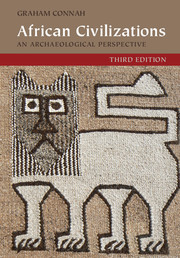Book contents
- Frontmatter
- Dedication
- Contents
- List of figures
- Preface and acknowledgements
- 1 The context
- 2 Origins: social change on the lower Nile
- 3 The Mediterranean frontier: North Africa
- 4 Sudanic genesis: Nubia
- 5 Isolation: the Ethiopian and Eritrean Highlands
- 6 Opportunity and constraint: the West African savanna
- 7 Achieving power: the West African forest and its fringes
- 8 Indian Ocean networks: the East African coast and islands
- 9 Cattle, ivory, and gold: social complexity in Zambezia
- 10 Central Africa: the Upemba Depression, Interlacustrine Region, and Far West
- 11 Settlement growth and emerging polities: South Africa
- 12 What are the common denominators?
- References
- Index
8 - Indian Ocean networks: the East African coast and islands
Published online by Cambridge University Press: 05 November 2015
- Frontmatter
- Dedication
- Contents
- List of figures
- Preface and acknowledgements
- 1 The context
- 2 Origins: social change on the lower Nile
- 3 The Mediterranean frontier: North Africa
- 4 Sudanic genesis: Nubia
- 5 Isolation: the Ethiopian and Eritrean Highlands
- 6 Opportunity and constraint: the West African savanna
- 7 Achieving power: the West African forest and its fringes
- 8 Indian Ocean networks: the East African coast and islands
- 9 Cattle, ivory, and gold: social complexity in Zambezia
- 10 Central Africa: the Upemba Depression, Interlacustrine Region, and Far West
- 11 Settlement growth and emerging polities: South Africa
- 12 What are the common denominators?
- References
- Index
Summary
‘Kilwa is one of the most beautiful and well-constructed towns in the world.’ This is how the much-travelled ibn Battuta described, first-hand, ‘the principal town on the [East African] coast’ in 1331. Kilwa (properly called Kilwa Kisiwani), situated in what is now Tanzania, was no isolated phenomenon. On the same coast, in what is now Somalia, was Mogadishu, of which he wrote that it was ‘a very large town’ (Freeman-Grenville 1975: 27–31). Ibn Battuta represented the scholarly opinion of the fourteenth-century Islamic world. By the end of the following century there were less-scholarly visitors from the Christian world of Western Europe, but they also were impressed with settlements on the East African coast. Thus in 1498, the unknown author of the Journal of the First Voyage of Vasco da Gama, 1497–1499 compared ‘the town of Malindi’ (now in Kenya) to Alcouchette, a town near Lisbon in his native Portugal (Freeman-Grenville 1975: 55–6). Indeed, the account of Vasco da Gama's second voyage (1502) by Gaspar Correa (written about 1561) describes Kilwa as follows:
The city is large and is of good buildings of stone and mortar with terraces, and the houses have much wood works. The city comes down to the shore, and is entirely surrounded by a wall and towers, within which there may be 12,000 inhabitants. The country all round is very luxuriant with many trees and gardens of all sorts of vegetables, citrons, lemons, and the best sweet oranges that were ever seen, sugar-canes, figs, pomegranates, and a great abundance of flocks, especially sheep, which have fat in the tail, which is almost the size of the body, and very savoury.(Freeman-Grenville 1975: 66)
The East African settlements would be expected to make a favourable impression on sailors several months outward bound from Portugal, who had just endured the eastern Atlantic on a dull if not inadequate diet. Nevertheless, historical sources such as these demonstrate that settlements of considerable size had already developed on the East African coast before the middle of the second millennium AD. Archaeological and oral traditional evidence supports this conclusion. The problem has been to explain how such a development took place, a development that was limited to a narrow strip comprising 3,500 kilometres of coastline, from southern Somalia to southern Mozambique and including various offshore islands, as well as the Comoro Archipelago and parts of Madagascar.
- Type
- Chapter
- Information
- African CivilizationsAn Archaeological Perspective, pp. 221 - 259Publisher: Cambridge University PressPrint publication year: 2015



